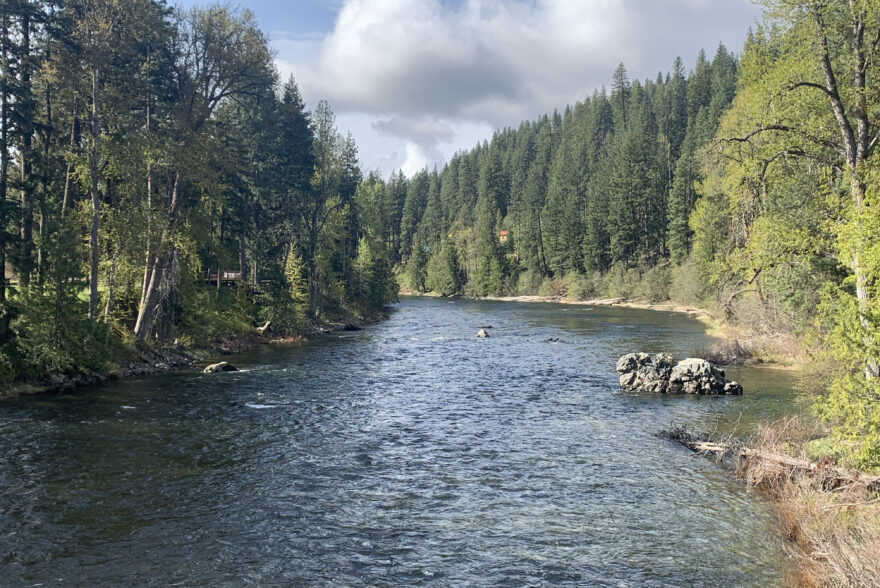Salmon, Snowpack, and Streamflow in the Wenatchee River Watershed


The recent launch of Blue Forest’s newest Forest Resilience Bond (FRB), the Upper Wenatchee I FRB, is the result of years of collaboration between government, nonprofit, and academic partners.
Written by: Kirsten Hodgson, Senior Science Communications Associate
As the first FRB to launch in Washington state, beneficiary contributions into the FRB resulted from Blue Forest’s ability to understand and anticipate the community and ecosystem benefits likely to result from the treatments planned as part of the Okanogan-Wenatchee National Forest’s Upper Wenatchee Pilot Project (UWPP).
Instrumental to that effort was modeling conducted by Dr. Mark Wigmosta, Chief Scientist at Pacific Northwest National Laboratory and one of Blue Forest’s science partners. Dr. Wigmosta and his colleagues began working with Blue Forest more than three years ago in discussions about modeling the hydrologic impacts of treatments planned for UWPP, particularly about how changes in snowpack accumulation and longevity might alter streamflow.
“There’s been some work that has shown that in the right locations, the right type of restoration can potentially increase peak winter snowpack, and in a perfect world increase early summer low flows. So is there a kind of triple win going on here where we reduce extreme wildfires, repurpose the [forest] residue for [for example] biochar or sustainable aviation fuel, and get a little more streamflow at critical times in the year?” says Dr. Wigmosta about the possible benefits of this kind of work that came up in these discussions.
But many of the hydrologic studies, Dr. Wigmosta says, assume that all the restoration work in a watershed happens at once, ignoring the impact that the timing of restoration work (which in reality happens incrementally over years) has on water resource benefits. These estimates are also highly location-dependent, with details like the slope or orientation in space of treatment sites influencing the outcomes we can expect to see.
For the Upper Wenatchee I FRB, Dr. Wigmosta and his colleagues “did some targeted [model] runs looking at smaller tributaries to try to get a feel in that location of what kind of potential increase in water yield you could see” to tailor expected outcomes to the planning location, he explains. Forest restoration activities typically reduce the density of the forest, leading to reduced interception of snowfall by the forest canopy. These treatments increase peak snowpack by reducing the loss of snow to the atmosphere through sublimation—when solid snow vaporizes without first melting into water—as well as by changing the rate of snowmelt underneath the canopy. Their findings showed that we can generally expect to see increased water yield (up to an additional 16,000 acre-feet of water over the next ten years) in the Wenatchee River Watershed resulting from UWPP treatments, supporting Blue Forest’s efforts to collaborate with downstream beneficiaries.
These results and similar outcomes from other model applications may have some implications for Pacific Northwest salmon populations, particularly if treatments can increase summertime streamflows or decrease water temperature even a little. Similarly, we might expect to see ecosystem benefits for other species as well, such as those whose life cycles depend on the presence of stable snowpack during the winter. These possibilities again depend on time and location, with differences in the amount of snowpack, time to snowmelt, and timing of streamflow likely to change based on variation in hillslope and aspect, exposure to sunlight, and overall weather (among many other factors).
Climate change is another complicating factor. As Dr. Wigmosta explains, “One of the takeaways is… climate change is a huge driver. The restoration can potentially help mitigate [the problem of low streamflow], but it’s not going to make [it] go away from a hydrologic point of view.”
Although this kind of modeling approach doesn’t provide blanket answers to questions about how forest restoration will impact ecosystems in the western U.S., it can provide a lot of insight into how and where restoration projects can effect change. The upside of all these outputs being so location dependent, Dr. Wigmosta says, is that in some cases it can be used to help inform where to prioritize management. And that could be true across much of the western U.S., where similar geographies face shared challenges to energy infrastructure, water supplies, and community wellbeing from fire and climate change.
“Hydrology, water, and fire interact with lots of relevant problems that we’re facing now and probably will be facing into the future,” Dr. Wigmosta says. “In the western U.S., so much of our water supply comes from snowpack. This kind of research is really valuable in those basins.”